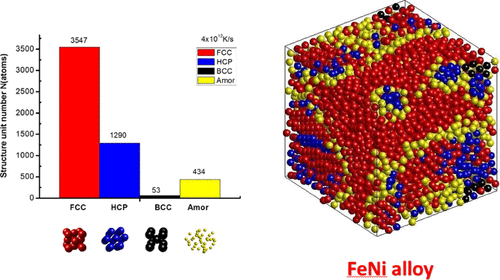Our official English website, www.x-mol.net, welcomes your
feedback! (Note: you will need to create a separate account there.)
Simulation on the Factors Affecting the Crystallization Process of FeNi Alloy by Molecular Dynamics
ACS Omega ( IF 3.7 ) Pub Date : 2019-08-23 00:00:00 , DOI: 10.1021/acsomega.9b02050 Dung Nguyen-Trong 1 , Kien Pham-Huu 2 , Phuong Nguyen-Tri 3
ACS Omega ( IF 3.7 ) Pub Date : 2019-08-23 00:00:00 , DOI: 10.1021/acsomega.9b02050 Dung Nguyen-Trong 1 , Kien Pham-Huu 2 , Phuong Nguyen-Tri 3
Affiliation

|
This paper investigates the crystallization process of FeNi alloys with different impurity concentrations of Ni(x) [x = 10% (Fe90Ni10), 20% (Fe80Ni20), 30% (Fe70Ni30), 40% (Fe60Ni40), and 50% (Fe50Ni50)] at temperature (T) = 300 K and Fe70Ni30 at heating rates of 4 × 1012, 4 × 1013, and 4 × 1014 K/s at different temperatures, T = 300, 400, 500, 600, 700, 900, 1100, and 1300 K. Molecular dynamics models with the Sutton–Chen embedded interaction potential and recirculating boundary conditions are used to calculate the molecular parameters of alloys, such as radial distribution function, total energy of the system (Etot), size (l), and crystallization temperature (through the relationship between Etot and T). The common neighborhood analysis method is used to confirm the theoretical results of crystallization for Fe–Fe, Fe–Ni, and Ni–Ni. The annealing process did not have an effect on the crystallization process of FeNi alloys. The effect of Ni content, heating rate, and annealing time on structural unit numbers, such as face-centered cubic, hexagonal close-packed, blocked cubic center, and amorphous, and the crystallization process of FeNi alloys is also investigated.
中文翻译:

FeNi合金结晶过程影响因素的分子动力学模拟
本文研究了不同杂质浓度的Ni(x)[ x = 10%(Fe 90 Ni 10),20%(Fe 80 Ni 20),30%(Fe 70 Ni 30),40% (Fe 60 Ni 40)和50%(Fe 50 Ni 50)]在温度(T)= 300 K和Fe 70 Ni 30下以4×10 12,4 ×10 13和4×10 14 K的加热速率/ s在不同温度下,T= 300、400、500、600、700、900、1100和1300K。具有Sutton–Chen嵌入的相互作用势和循环边界条件的分子动力学模型用于计算合金的分子参数,例如径向分布函数,系统的总能量(E tot),尺寸(l)和结晶温度(通过E tot和T之间的关系)。常用的邻域分析方法用于确认Fe–Fe,Fe–Ni和Ni–Ni结晶的理论结果。退火过程对FeNi合金的结晶过程没有影响。还研究了镍含量,加热速率和退火时间对结构单元数的影响,例如面心立方,密排六方,立方中心封闭和无定形,以及FeNi合金的结晶过程。
更新日期:2019-08-23
中文翻译:

FeNi合金结晶过程影响因素的分子动力学模拟
本文研究了不同杂质浓度的Ni(x)[ x = 10%(Fe 90 Ni 10),20%(Fe 80 Ni 20),30%(Fe 70 Ni 30),40% (Fe 60 Ni 40)和50%(Fe 50 Ni 50)]在温度(T)= 300 K和Fe 70 Ni 30下以4×10 12,4 ×10 13和4×10 14 K的加热速率/ s在不同温度下,T= 300、400、500、600、700、900、1100和1300K。具有Sutton–Chen嵌入的相互作用势和循环边界条件的分子动力学模型用于计算合金的分子参数,例如径向分布函数,系统的总能量(E tot),尺寸(l)和结晶温度(通过E tot和T之间的关系)。常用的邻域分析方法用于确认Fe–Fe,Fe–Ni和Ni–Ni结晶的理论结果。退火过程对FeNi合金的结晶过程没有影响。还研究了镍含量,加热速率和退火时间对结构单元数的影响,例如面心立方,密排六方,立方中心封闭和无定形,以及FeNi合金的结晶过程。

































 京公网安备 11010802027423号
京公网安备 11010802027423号